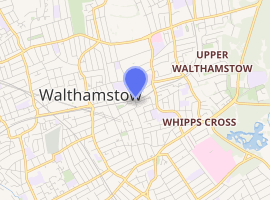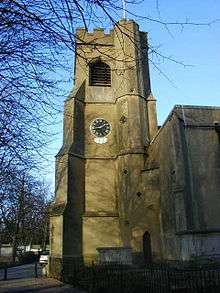St. Mary's Church, Walthamstow
St. Mary’s Church, Walthamstow, is in Walthamstow Village, a conservation area in Walthamstow, London. It was founded in the 12th century and is still a working church. It retains over one hundred and fifty brasses and monuments, the oldest dating from 1436, though all that now remains of the original Norman church is some pillar bases and the chisel marks on them.
| St. Mary's Church, Walthamstow | |
|---|---|
View of St. Mary's Church from Vinegar Alley | |

| |
| Location | Walthamstow Village, London |
| Country | United Kingdom |
| Denomination | Church of England |
| Administration | |
| Diocese | Chelmsford |
History
The first church building on the site was constructed in the 12th century, and measured about 15 metres by 8 metres (46 feet by 24 feet) with a sanctuary or chancel of unknown size at the east end. It was probably built of flint rubble and stood where the present nave now stands.
It is believed that the north aisle of the church was rebuilt in the 13th century and the south aisle in the 14th century, both extending east only as far as the current chancel arch. In the 15th century a tower was added at the west end and the chancel was also extended eastward.
In 1535, Sir George Monoux, Alderman of London and Master of the Worshipful Company of Drapers, one of the guilds of the City of London, repaired the north aisle and built a chapel on the east end of it running along the north wall of the chancel. At the same time, Monoux demolished the top 40 feet (12 m) of the tower and rebuilt it in Tudor brick, adding a spiral stairway in a turret at the south-east corner of the tower. In the same year, money from Robert Thorne (a wealthy London merchant who, like Monoux, originated from Bristol and became Lord Mayor of the City of London) was used to completely rebuild the south aisle and to add a chapel on its eastern end.
Internal galleries to provide extra seating for the congregation were added in the 18th century, the first being constructed at the west end of the church in 1710, with further galleries being built in the north and south aisles during the course of the century. In 1819, the aisle galleries were linked with the western one, and the walls of the nave at the west end were increased in height. At the same time, the old windows of the nave were bricked up and the present Gothic revival ones cut. In 1843, the rest of the walls of the church were increased in height to match that of the west end, and the pillars of the nave were heightened and remodelled to their present shape, leaving only the column bases as the final remnant of the 12th-century church above ground level. A rose window was also inserted in the east wall of the chancel. The new parish of St Peter's was split off from the parish in 1845.
In 1876, the galleries were 'thrown back' from the nave pillars (i.e. reduced in width by one half), an older plaster ceiling was removed and a roof of stained wood installed. The private box pews which had accrued in the nave since the Reformation were also removed and replaced by open benches which were, in turn, superseded by the current pews in the 1920s, together with oak panelling to the rear and sides of the church and in the galleries as a First World War memorial. Choir stalls of carved oak were given to the church by Sir William Mallinson in 1939 in memory of his father.

In 1936 the east wall was found to be suffering from structural failure and, during the course of repairs, the opportunity was taken to rebuild that part of the church and extend the chancel 3 metres (12 feet) east and to build vestries on either side. In 1939, a large window in perpendicular gothic style was added to the east end of the church.
St Mary's suffered serious damage during Second World War. On 4 October 1940 the south aisle roof was destroyed by incendiary bomb and the gallery on that side was subsequently demolished to provide timber for repairing the church. On 8 October 1944, a bomb damaged the north side of the church tower. It was reported that a bomb disposal officer who investigated the scene in the dark could "feel the shape of a bomb and the jagged edge of its fins." The churchyard was closed for two Sundays pending investigations. It transpired that the "bomb" was an old lead coffin, broken open by debris failing from the tower.
During the spring of 1942 all the railings surrounding the churchyard and most of those round the monuments were removed to provide scrap iron help the war effort. All that remained were the north and south gates.
Post-war restoration of the church included a new heating system (with a boiler house built outside the north porch) and the rebuilding of the organ. The railings outside were replaced in 1955. In the early 1960s the east end of the south aisle was remodelled to create a side chapel.
Between 1995 and 2001, extensive refurbishment of the church took place, which included removing three rows of pews from the west end of the nave, reflooring and creating a larger entrance area adjacent to the west door. When the floor was removed some of the crypt underneath the church were rediscovered. During the same work, when the ceiling from the entrance lobby underneath the bell tower was removed, it revealed several large oak beams probably used during the reconstruction of the tower in the 16th century. It was decided that these beams would be refurbished and left permanently exposed; the 18th century beams of the south porch roof were similarly restored and left exposed. At the same period a disabled toilet and refreshment area were installed and the sanctuary was reordered.
In 2001, the floor of the chancel was lowered and extended into the nave to provide an open space for worship. Two of the choir stalls were retained in the sanctuary and the rest relocated to the west end of the gallery. Communion can now be celebrated at the front of the nave and served on three sides.
Churchyard
The churchyard contains war graves of three service personnel of World War II and nine of World War II.[1]
St. Mary's today
St. Mary's is an active church today, with a large multi-cultural congregation and involved in supporting its local community.
The church is now also a music and recording venue. Currently Peter McCarthy runs the "Music in the Village" series of concerts and other local groups such as London Forest Choir use the venue for concerts. The Stow (Walthamstow) Festival also uses the venue.